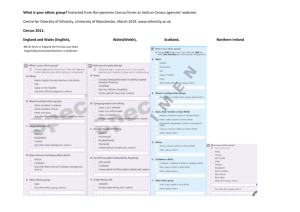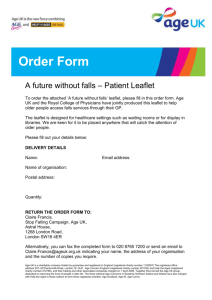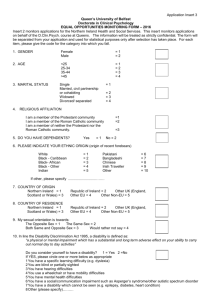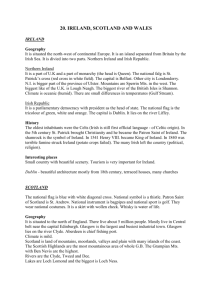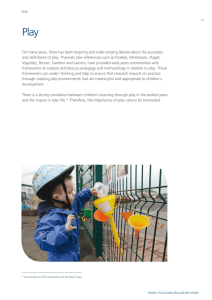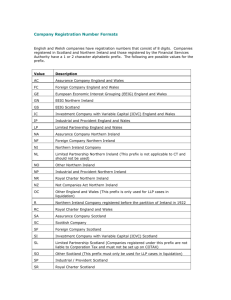Unit MU 2.8 Contribute to the support of positive environments for
advertisement
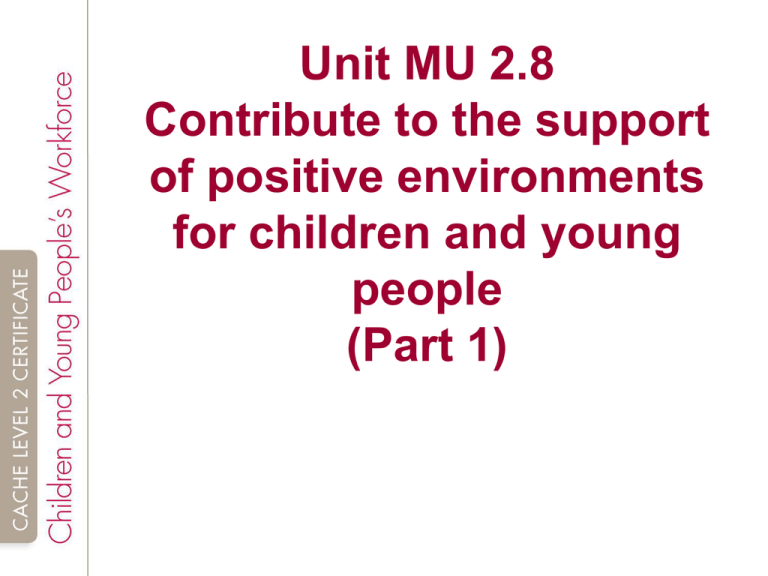
Unit MU 2.8 Contribute to the support of positive environments for children and young people (Part 1) MU 2.8 Contribute to the support of positive environments for children and young people 3 credits This unit helps learners to: • Know about the regulatory requirements for a positive environment • Be able to support a positive environment that meets an individual’s needs • Be able to support the personal care needs of children and young people • Understand how to support the nutritional and dietary needs of children and young people. Big Picture Lesson 1 Connector… Why it is important for a child/young person to be in a positive environment? Work in pairs to discuss your ideas. Be prepared to give feedback to the class. Positive environments • A positive environment is somewhere that is welcoming, reassuring, safe and healthy; it is one in which children/young people can learn and develop. • A positive environment helps children and young people to become independent, to have the confidence to learn new skills and to feel a sense of belonging. • A positive environment should provide for the physical, intellectual, language, emotional and social needs of the child or young person. The required regulations Learning Outcome 1 There are a number of frameworks in England, Scotland, Wales and Northern Ireland which state the regulations that must be followed in children’s and young person’s childcare and educational establishments. • • • • ‘The curriculum framework for England’ ‘The curriculum framework for Scotland’ ‘The curriculum framework for Wales’ ‘The curriculum framework for Northern Ireland’ Find out about these for 1.1. & 1.2 Activity 2 The required regulations It is important to know that the laws are slightly different in each of the UK countries. Each group to research the following laws •‘The curriculum framework for England’ •‘The curriculum framework for Scotland’ •‘The curriculum framework for Wales’ •‘The curriculum framework for Northern Ireland’ Be prepared to give feedback to the class What is a positive environment? A positive environment is one: • that is safe and hygienic • where there is no discrimination • where young children and young people are cared for by people who have a caring attitude and approach • where children and young people are stimulated • where there is equality of opportunity • where there are activities and opportunities for play • where individual needs are met. A positive environment • Should provide for each individual’s needs. Think of 2/3 children or young people you are working with. Are their needs being met? • Should offer a wide range of activities that allow children and young people to try things out (experiment) and that encourage them to solve problems. Can you think of activities that could be offered? • Should provide opportunities for taking part in activities, indoors and outdoors, and with peers. Activity 3: Being able to support a positive environment 2.1 • In your placement, how do practitioners greet each young person or child? • In what ways are they made to feel valued as an individual? • Which routines are in place? • What opportunities are there for taking part in a variety of activities? What does the young people’s environment offer? 2.2 • What opportunities are there for the young people to choose their own activities? Make a list of them. When do they do them? • How much time do they get to engage in activities of their own choosing? Activities 4 Helping children to feel valued textbook page 152 And Reflective practice: Welcoming children and young people page 153 Activity 5 Work in pairs to answer the following questions; Any setting must take into account the particular needs of each child or young person. What might be done to help: •A child or young person who uses a wheelchair? •A child or young person with hearing difficulties? •A child or young person with very poor eyesight (visually impaired)? •A child or young person with limited mobility? •A stressed or anxious child or young person? Creating a friendly Early Years environment 2.2 This involves planning the layout and organising the activities so that children can have an active role in setting up and choosing what they want to do. Outdoor access Health and safety Interest tables child height? objects safe to handle? Are displays visible? How is the space divided to allow for a variety of activities? Things to think about Lighting natural and artificial Is the space big enough? Temperature of room 18–21C Resources 2.2 • Remember! You are the child’s most valuable resource. Equipment • In your Early Years work environment, what opportunities are there for children to play with, sand clay and play dough water • • Where is the quiet area? What tabletop activities are there? e.g. puzzles, small blocks • What technology equipment can they use? e.g. computer Can you think of others? Can children take part in….? Cookery Domestic play (dolls, telephones etc.) Make-believe play (dressing up clothes) Art work What else does the Early Years work environment offer: • What construction toys can they play with? • Are there facilities for reading and writing? • Can they make models etc. from boxes, toilet roll tubes, egg boxes etc? • Is there an interest table? What is featured? • Are there ‘growing and living’ things, e.g. fish, plants ? Outdoors 2.2 • What outdoor equipment is provided? • How do you know that the outdoor equipment is safe? • What about the outdoor floor surface – is it suitable and safe? • Is there a garden? What can the children or young people learn about garden life – plants, insects etc? Providing activities and resources 2.3 • Activities and resources should always be planned with the individual in mind. • A child or young person’s needs should be regularly assessed. • Those with particular needs should have the same opportunities as others. • Settings may need to be adapted for those with additional needs, e.g. wheelchair users. Providing activities that will encourage the use of a child or young person’s senses 2.4 Touch e.g. a variety of materials with different textures Taste Smell e.g. sampling sweet & sour foods e.g. cooking Hearing Senses Sight e.g. reading e.g. listening to music What other activities can you think of for each of these? Providing an environment where praise and encouragement are given 2.5 Sharing experiences / circle time Highlighting the positive aspects – especially effort How to give praise and encouragement Non-verbal methods e.g. smiling, eye contact Verbal praise and encouragement Displaying work Sharing positive feedback Assessment task 1 • You have to produce an information leaflet for children, young people and parents/carers. • This leaflet is intended to explain all about ‘positive environments’: - what is a positive environment? - what makes a positive environment? - what regulations have to be followed? You might find it useful to discuss these questions before starting your leaflet. Review Write down some of the ways positive environments can be created


